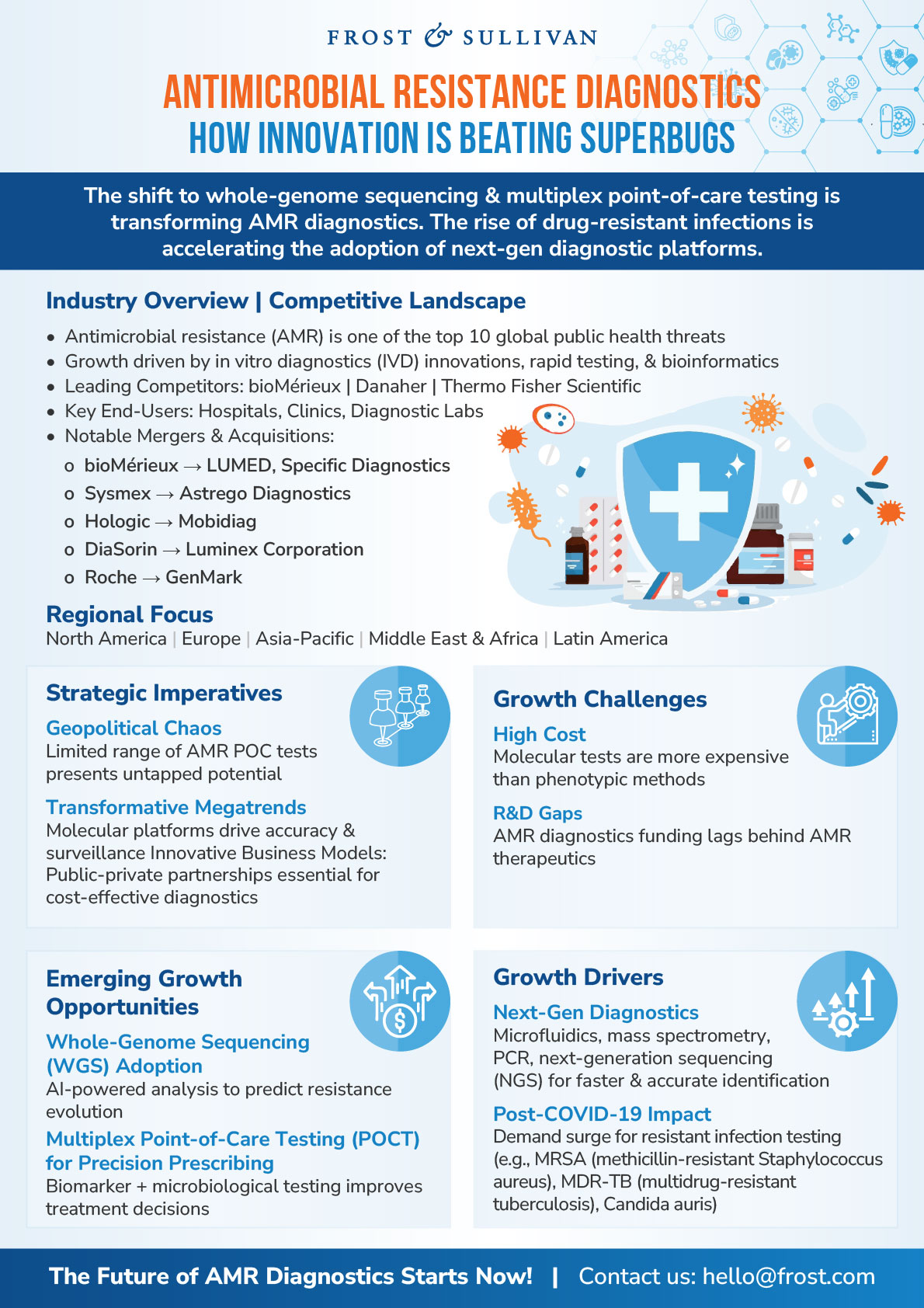The Growing Crisis of AMR & the Role of Diagnostics
Antimicrobial resistance (AMR) is a rising global health crisis, with drug-resistant bacteria, viruses, and fungi threatening effective disease management. Traditional diagnostic methods struggle to keep pace, leading to increased adoption of next-generation molecular diagnostics. These innovations enhance speed, accuracy, and precision in treatment decisions.
Want deeper insights? Download our full analysis on the Antimicrobial Resistance Diagnostics Market. Click here to download
Industry Overview: AMR Diagnostics at a Crossroads
The AMR diagnostics market is evolving, driven by demand for rapid, high-throughput solutions in hospitals, clinics, and labs. Emerging trends include:
- The increasing adoption of whole-genome sequencing (WGS) for real-time pathogen detection
- The integration of AI-powered bioinformatics tools to predict resistance mechanisms
- The rise of multiplex point-of-care testing (POCT) to enable faster treatment decisions

Strategic Imperatives Driving Growth
- Disruptive Technologies: WGS & AI in AMR Surveillance – Whole-genome sequencing (WGS) is emerging as a gold standard for AMR surveillance, enabling early outbreak detection, resistance profiling, and precision prescribing. The integration of AI-based bioinformatics platforms is further enhancing real-time data analysis, leading to more effective antimicrobial stewardship programs.
- The Shift Toward Multiplex POCT – Multiplex POCT is transforming AMR diagnostics by enabling simultaneous pathogen identification and biomarker detection at the point of care. This approach:
- Reduces reliance on empirical antibiotic prescribing
- Improves precision treatment strategies in primary care and rural healthcare settings
- Helps build an antibiotic resistance database for targeted intervention
- Competitive Intensity & Market Leadership – The AMR diagnostics industry is highly consolidated, with bioMérieux, Danaher, and Thermo Fisher Scientific controlling 84% of market share. Strategic acquisitions—such as Hologic acquiring Mobidiag and Roche acquiring GenMark—underscore the race for diagnostic dominance.
Challenges & Market Constraints
While the AMR diagnostics industry presents transformative opportunities, significant challenges remain:
- Affordability Constraints: Molecular tests are costlier than phenotypic methods, limiting widespread adoption in low-income regions.
- Regulatory Barriers: Stringent regulatory pathways delay commercialization and adoption.
- Funding Gaps: AMR diagnostics receive three times less R&D funding than AMR therapeutics, slowing innovation.
Emerging Growth Opportunities
- WGS as a Game-Changer in AMR Surveillance: Advancements in next-generation sequencing (NGS) technology and AI-driven bioinformatics are making WGS more accessible. Stakeholders should invest in automation solutions and leverage real-time data analytics to improve efficiency and affordability.
- Expanding Multiplex POCT in Decentralized Settings: The implementation of multiplex POCT in pharmacies, outpatient clinics, and rural healthcare centers will drive adoption. By integrating microbiological and biomarker POCT, healthcare providers can:
- Enhance precision prescribing
- Optimize local antimicrobial susceptibility mapping
- Reduce overcrowding in hospitals
The Future of AMR Diagnostics
The shift to next-generation molecular platforms is revolutionizing AMR detection, guiding antimicrobial stewardship, and reducing healthcare burdens worldwide. To stay competitive, businesses must:
- Invest in AI-powered WGS platforms
- Expand multiplex POCT capabilities
- Leverage strategic partnerships for global expansion
Are you ready to navigate the future of AMR diagnostics? Explore our latest research for in-depth insights and strategic recommendations!



